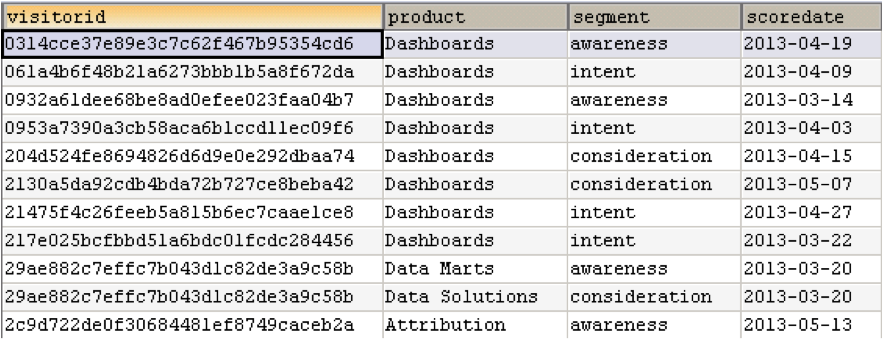Blog and News > conversions > Improving Website Conversion Rates with Visitor Analytics
Improving Website Conversion Rates with Visitor Analytics
Tracking and optimizing conversion rates remains an overwhelming obsession for a majority of Digital Marketing Teams despite the disproportionate time spent getting this one single metric right, the actual definition of conversion rate remains largely vague and poorly defined resulting in misguided optimization strategies and measurement programs
Let us take the example of a subscription based site and explore flaws with ‘Traditional’ measurement techniques for conversion rate optimization and how Visitor Analytics can serve as a powerful alternative
We take the example of a site in Financial Services domain which sells multiple products including
- SaaS based Trading Platform for real time trading in a variety of instruments
- Level 2 access to major Stock Markets
- Bespoke Research Services for Equities, Bonds, Commodities and other asset classes
- Raw data feeds from Reuters based on customer defined filters
The ultimate aim of the site is to be able to increase subscriptions for each of these services. The issue however, has to do with how conversion rate is actually defined. Here are some definitions we regularly come across
- Number of sessions (not actual visitors) where there is a trial account signup divided by total number of pageviews for a given product page
- % of sessions that involve completion of an arbitrary conversion funnel (typically one funnel per conversion type)
- Number of trial account signups divided by the total number of unique visitors that come in for certain keywords (where each keyword indicates intent for a given service)
The shortcomings of each definition should be obvious. One-off pageviews for any page are hardly an indication of intent to purchase. Even if they were, there is no account for time dimension. Someone who viewed a page 1 month ago is treated the same as someone who did so within last 24 hrs.
In funnel based definitions, it is impossible to create a proxy for purchase intent using a funnel. There would inevitably be numerous visitors who start the funnel but who had no intention of actually signing up. Using funnels as a proxy for calculating conversion rates simply ends up bulking the actual figures. Using keywords as a proxy for identifying visitor intent is no less adequate simply because visitors might come in from certain keywords and then undertake a series of visits through other channels before actually signing up.
Session based Analytics is simply not geared towards capturing such instances
Now imagine that there was a way of somehow allocating each website visitor to a unique segment based on analysis of all his pageviews (or other site interactions that can be modelled as pageviews) over a given period of time. A Sample database capturing these entries would look like so-

Two things happen behind the scenes in creating this database-
- All content on the website has been classified with at least two dimensions: a) product/service for which it shows content (e.g. Dashboards, Data Solutions, Attribution Modelling etc.) and b) the intended purpose of that page (e.g. drive awareness about a service, provide more in-depth knowledge about features, capture leads etc.)
- Once such a classification has been implemented, each visitor can be allocated a score for every product/segment combination based on analysis of ALL his pageviews across multiple sessions.
The actual method of allocating each visitor to a segment is complex and involves a lot of under the covers data plumbing. The output however, is a far more accurate representation of intent of particular products than any session based data analysis. With this data information at hand, conversion rates can be defined with significantly greater precision. An example rule would be
Conversion rate for Product X over Period Y = Total Number of trial signups for Product X over Period Y divided by the total number of Visitors in ‘Consideration’ segment for same product over same period
Using this rule, you could safely exclude visitors who signup but do not figure in the awareness segment. As long as these numbers are small (outliers in statistical terms) your rule remains functionally valid. If however, these numbers are high, you may need to revisit your page classification and segmentation definitions.
Summary
Shifting focus to visitors in manner outlined above pays off big time. The figures for key metrics and KPIs are significantly more accurate and resulting insights far more actionable. In the example above, it is clear that to improve conversion rates for a given product, you need to increase the number of people entering its ‘consideration’ stage and then increasing the percentage that converts. This can be done by making targeted improvements to usability and/or content through well-defined split tests for these specific pages
Notice that the scenario above is not applicable to just B2B sites and that the underlying re-usable asset is visitor level data intelligence which can be easily mined for eCommerce sites with an aptly designed segmentation scheme
Author by-line
Dheeraj Saxena is Principal Consultant at LVMetrics where he specializes in building bespoke data analysis and Behavioural Segmentation schemes from Visitor level clickstream data. You can reach him on dsaxena@lvmetrics.com and follow LVMetrics on @lvmetrics